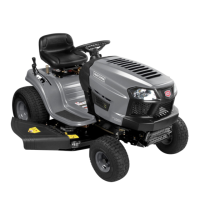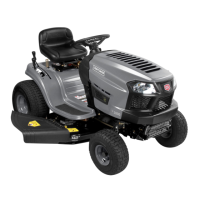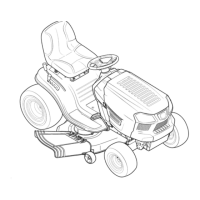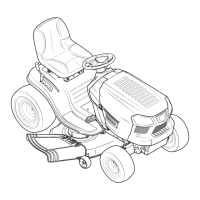25
SERVICE AND MAINTENANCE
Maintenance
Engine
Refer to the Engine Operator’s Manual for all engine issues and questions.
Note : Maintenance, repair, or replacement of the emission control devices and systems which
are being done at owner’s expense may be performed by any engine repair establishment or
individual. Warranty repairs must be performed by an authorized dealer.
Battery
WARNING
California Proposition 65
Battery posts, terminals, and related accessories contain lead and lead
compounds, chemicals known to the State of California to cause cancer and
reproductive harm. Wash hands after handling.
The battery is sealed and is maintenance-free. Acid levels cannot be checked and
fluid can not be added.
• Always keep the battery cables and terminals clean and free of corrosive build-
up.
• After cleaning the battery and terminals, apply a light coat of petroleum jelly
or grease to both terminals.
CAUTION
If removing the battery for cleaning, disconnect the NEGATIVE (Black)
wire from it’s terminal first, followed by the POSITIVE (Red) wire. When
re-installing the battery, always connect the POSITIVE (Red) wire its terminal
first, followed by the NEGATIVE (Black) wire. Be certain that the wires are
connected to the correct terminals; reversing them could result in serious
damage to your engine’s alternating system.
Jump Starting
WARNING
Never jump start a damaged or frozen battery. Be certain the vehicles do not
touch.
1. Connect positive (+) cable to positive (+) post of your tractor’s discharged
battery.
2. Connect the other end of the cable to the positive (+) post of the jumper
battery.
3. Connect the second cable negative (–) to the other post of the jumper battery.
4. Make the final connection on the engine block of the tractor, away from the
battery. Attach to an unpainted part to assure a good connection.
5. Start the tractor (as instructed in the Operation section of this manual).
6. Remove the jumper cables in reverse order of connection.
Charging
WARNING
Batteries give off an explosive gas while charging. Charge the battery in a
well ventilated area and keep away from an open flame or pilot light as on a
water heater, space heater, furnace, clothes dryer or other gas appliances.
• Clean the top of the mower deck, under the spindle covers and belt area. See
Figure 30.
Figure 30
• Clean around and near the transmission, axle and the fan area. See Figure 31.
Wheel Not Shown For Clarity
Figure 31
• Debris can accumulate anywhere on the tractor, especially on horizontal
surfaces. Additional cleaning may be necessary when mowing in dry
conditions or when mulching.
• Fuel leaks/spills, oil leaks/spills and excess lubrication can also become
collections sites for debris. Immediate repair and cleaning up oil or fuel spills
can help reduce fire hazards.
• In addition to cleaning the tractor before operating and storing, do not
attempt to mow unusually tall grass (10” or higher), dry grass (e.g., pasture) or
piles of dry leaves. Dry grass or leaves may contact the engine exhaust and/or
build up on the mower deck presenting a potential fire hazard.
Storing the Tractor
• Allow the machine to cool in an open area before storing.
• Do not park the tractor near any flammable materials (wood, cloth or
chemicals) or any open flames or other potential source of ignition (furnace,
water heater or any other type of heater).
• Remove all combustible materials from the tractor before storing. Empty
cargo boxes, grass catchers or containers.
• Always shut off fuel flow when storing or transporting if tractor is equipped
with a fuel shutoff.
• Check the fuel system (lines, tank, cap and fittings) frequently for cracks or
leaks. Repair and clean as necessary.
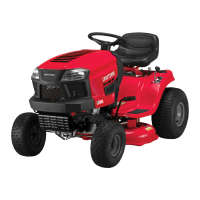
